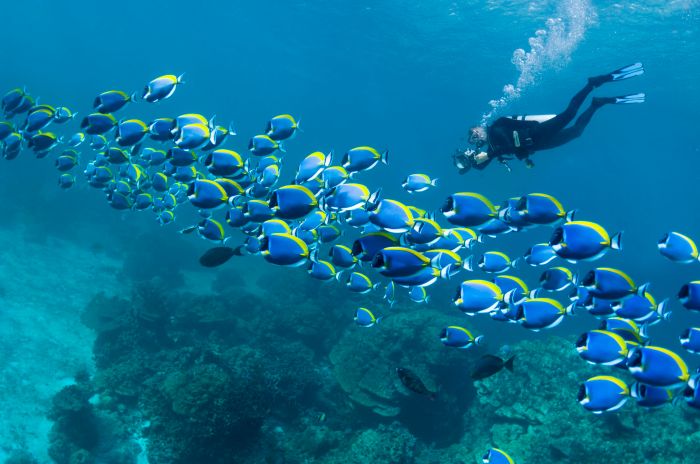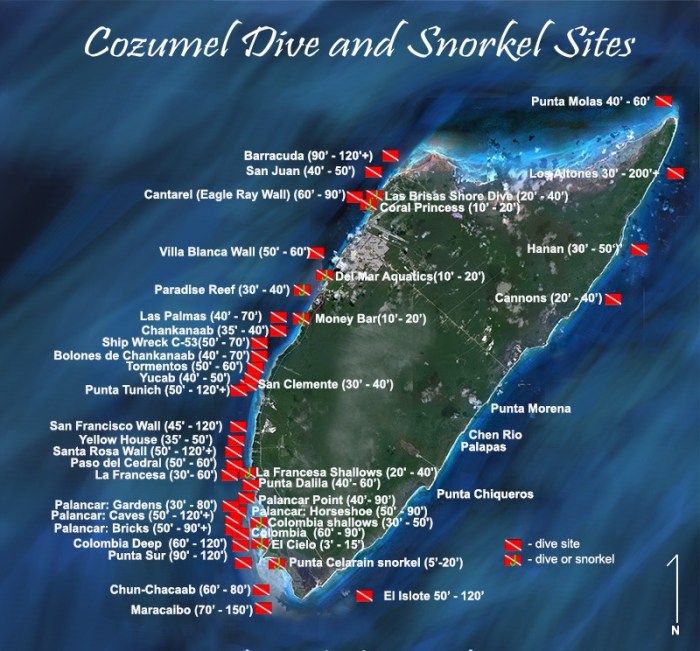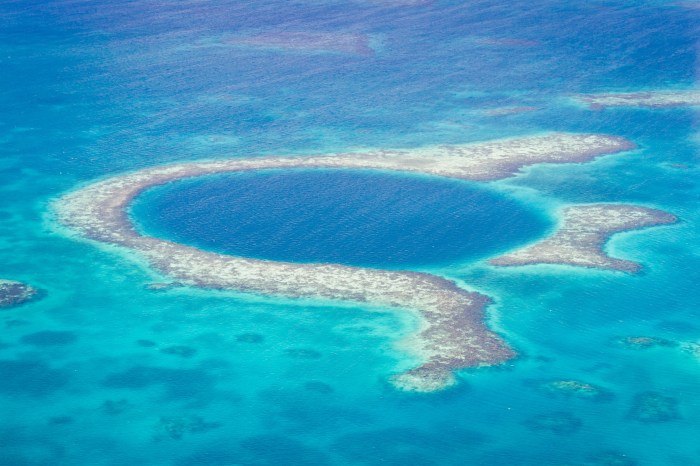Scuba diving locations offer a mesmerizing glimpse into the hidden depths of our planet, where vibrant marine life and awe-inspiring underwater landscapes await exploration. From beginner-friendly reefs to thrilling wreck dives, the world’s oceans beckon with an array of dive sites that cater to every level of experience.
Whether you’re a seasoned diver or planning your first underwater adventure, this guide will equip you with the knowledge and inspiration to discover the wonders that lie beneath the waves.
Scuba Diving Destinations

The world’s oceans offer a vast array of scuba diving destinations, each with its unique characteristics and marine life. From beginner-friendly sites to challenging wreck dives and vibrant coral reefs, there’s a location to suit every diver’s interests and skill level.
To help you plan your next underwater adventure, here’s a comprehensive list of popular scuba diving destinations worldwide:
Beginner-Friendly Destinations
For those new to scuba diving or seeking relaxed dives, several destinations offer calm waters and gentle currents, making them ideal for beginners:
- Koh Tao, Thailand: Known for its crystal-clear waters, shallow dive sites, and abundance of marine life.
- Great Barrier Reef, Australia: A UNESCO World Heritage site with over 2,900 individual reefs and countless dive sites suitable for all levels.
- Maldives: Boasts over 1,000 islands with pristine waters, colorful coral gardens, and gentle sea turtles.
Wreck Diving Destinations
For divers seeking historical exploration and underwater adventures, these destinations offer access to sunken ships and other submerged wrecks:
- Truk Lagoon, Micronesia: Home to over 60 shipwrecks from World War II, providing a glimpse into maritime history.
- Thistlegorm, Red Sea, Egypt: A British cargo ship sunk in 1941, now a popular wreck diving site with its intact cargo and marine life.
- SS Yongala, Australia: A passenger ship that sank in 1911, now an artificial reef teeming with marine life and accessible to experienced divers.
Coral Reef Diving Destinations
Divers seeking vibrant and diverse marine life will find these destinations offer stunning coral reefs and a kaleidoscope of underwater colors:
- Raja Ampat, Indonesia: Renowned for its incredible biodiversity, with over 1,500 species of fish and 600 species of coral.
- Cozumel, Mexico: Home to the second-largest barrier reef in the world, with excellent visibility and abundant marine life.
- Palau: A Micronesian archipelago with pristine coral reefs, diverse marine life, and unique underwater landscapes.
Diving Conditions

Scuba diving conditions can vary significantly depending on several factors, including water temperature, visibility, currents, and marine life. These factors can affect the safety, enjoyment, and overall experience of a dive.
Before planning a diving trip, it’s crucial to research and understand the diving conditions at the intended location and time of year. This information can help divers make informed decisions about the appropriate equipment, dive plans, and safety precautions.
Water Temperature, Scuba diving locations
Water temperature is a key factor that influences the comfort and safety of a dive. Divers must wear appropriate thermal protection, such as wetsuits or drysuits, to maintain their body temperature and prevent hypothermia.
Optimal water temperatures for diving typically range from 75°F (24°C) to 85°F (29°C). However, divers may encounter colder or warmer temperatures depending on the location and season.
Visibility
Visibility underwater can vary depending on factors such as water clarity, suspended particles, and depth. Good visibility allows divers to see clearly and enjoy the underwater environment.
Optimal visibility for diving is generally considered to be 50 feet (15 meters) or more. However, visibility can be significantly reduced in certain areas due to factors such as plankton blooms, sediment, or strong currents.
Currents
Currents can affect the difficulty and safety of a dive. Strong currents can make it challenging to navigate and control buoyancy, while weak currents can provide an assist and reduce the effort required for swimming.
Divers should be aware of the current conditions at their dive site and plan their dives accordingly. It’s important to avoid diving in areas with strong currents or unpredictable flow patterns.
Marine Life
The presence of marine life can enhance the diving experience and provide opportunities for observing underwater creatures. However, divers must be respectful of marine life and follow responsible diving practices to avoid disturbing or harming the environment.
Some dive sites are known for their abundance of specific marine species, such as sharks, rays, or coral reefs. Divers can research the marine life at their intended dive site to learn about the potential encounters and appropriate behavior.
Dive Sites

Dive sites encompass diverse underwater environments, offering unique experiences for divers of all levels. From vibrant coral reefs teeming with marine life to historic shipwrecks and enigmatic underwater caves, each site presents its own captivating allure.
Coral Reefs
Coral reefs are vibrant underwater ecosystems teeming with an astonishing array of marine life. Their intricate structures provide shelter and sustenance to a multitude of species, from tiny invertebrates to majestic sea turtles and sharks. Notable coral reef dive sites include:
- Great Barrier Reef, Australia: The world’s largest coral reef system, renowned for its pristine waters and kaleidoscopic marine life.
- Raja Ampat, Indonesia: A marine sanctuary boasting over 1,500 islands, offering pristine coral reefs and exceptional biodiversity.
- Cozumel, Mexico: Home to the second-largest barrier reef in the world, known for its crystal-clear waters and vibrant marine life.
Wrecks
Shipwrecks are fascinating underwater time capsules, offering a glimpse into maritime history and providing a habitat for diverse marine life. Some notable wreck dive sites include:
- SS Thistlegorm, Egypt: A British merchant ship sunk in 1941, now resting in the Red Sea and renowned for its well-preserved cargo.
- USS Arizona, Hawaii: A battleship sunk during the attack on Pearl Harbor, now a memorial and a popular dive site.
- RMS Titanic, North Atlantic: The infamous luxury liner that sank in 1912, offering a poignant and historically significant dive experience.
Underwater Caves
Underwater caves offer a unique and adventurous diving experience, leading divers into hidden chambers and subterranean tunnels. Notable underwater cave dive sites include:
- Blue Grotto, Malta: A shallow cave with an entrance at sea level, renowned for its ethereal blue waters and stunning light effects.
- Actun Tunichil Muknal, Belize: A sacred Mayan cave system with pristine chambers, ancient artifacts, and crystal-clear waters.
- Orda Cave, Russia: The deepest underwater cave in the world, offering a challenging and rewarding dive experience for experienced divers.
Marine Sanctuaries
Marine sanctuaries are designated areas of the ocean that provide protection for marine ecosystems and wildlife. These sites offer exceptional diving opportunities, showcasing a rich diversity of marine life and pristine underwater environments. Notable marine sanctuary dive sites include:
- Galapagos Marine Reserve, Ecuador: A UNESCO World Heritage Site known for its unique marine life, including sea lions, marine iguanas, and giant tortoises.
- Great Barrier Reef Marine Park, Australia: A vast marine park encompassing the Great Barrier Reef, offering world-class diving experiences and unparalleled biodiversity.
- Raja Ampat Marine Park, Indonesia: A marine park known for its stunning coral reefs, pristine waters, and abundant marine life.
When choosing a dive site, consider your experience level, interests, and the type of diving you wish to experience. For beginners, choosing sites with calm waters, good visibility, and shallow depths is recommended. Experienced divers may seek out more challenging dives, such as wreck exploration or cave diving. Ultimately, the best dive site is one that aligns with your interests and provides a safe and memorable diving experience.
Scuba diving is a thrilling activity that offers a chance to explore the underwater world. If you’re looking for an extreme sports vacation, scuba diving is a great option. There are many different scuba diving locations around the world, each with its own unique attractions.
Whether you’re a beginner or an experienced diver, there’s sure to be a scuba diving location that’s perfect for you. Extreme sports vacations are a great way to experience the thrill of scuba diving, as well as other extreme sports like rock climbing, mountain biking, and skydiving.
Marine Life: Scuba Diving Locations
Scuba diving offers an unparalleled opportunity to witness the extraordinary diversity of marine life up close. From vibrant fish and graceful sharks to majestic rays and ancient turtles, the underwater world is teeming with an astonishing array of species.
When seeking out scuba diving locations, it’s crucial to consider the needs of your family. Family-friendly resorts offer a wide range of activities and amenities to keep both adults and children entertained. From shallow waters for beginners to guided tours for experienced divers, these resorts provide a safe and enjoyable environment for the whole family to explore the underwater world.
The abundance and variety of marine life vary significantly from one diving destination to another, depending on factors such as water temperature, depth, and nutrient availability. However, some of the most commonly encountered marine species include:
Fish
- Tropical fish: These brightly colored and often small fish are found in warm, shallow waters around the world. They include species such as clownfish, damselfish, and parrotfish.
- Pelagic fish: These larger, open-ocean fish include tuna, marlin, and sharks. They are often found in deep, blue waters.
- Bottom-dwelling fish: These fish live on or near the ocean floor. They include species such as flounders, halibut, and eels.
Sharks
- Reef sharks: These small to medium-sized sharks are often found near coral reefs. They include species such as the blacktip shark and the whitetip reef shark.
- Pelagic sharks: These larger, open-ocean sharks include species such as the great white shark and the tiger shark.
Rays
- Stingrays: These flat, bottom-dwelling rays have a venomous barb on their tails. They include species such as the southern stingray and the cownose ray.
- Eagle rays: These large, pelagic rays have long, wing-like pectoral fins. They include species such as the spotted eagle ray and the manta ray.
Turtles
- Hard-shelled turtles: These turtles have a hard, bony shell. They include species such as the green sea turtle and the hawksbill turtle.
- Soft-shelled turtles: These turtles have a soft, leathery shell. They include species such as the leatherback turtle and the Kemp’s ridley turtle.
Dolphins
- Common dolphins: These are the most widespread species of dolphin. They are found in all oceans except the Arctic.
- Bottlenose dolphins: These dolphins are known for their intelligence and playfulness. They are found in warm and temperate waters around the world.
The marine environment is a fragile and interconnected ecosystem. It is important for divers to practice responsible diving techniques to minimize their impact on marine life and their habitats. This includes:
- Avoiding touching or harassing marine life.
- Not feeding marine life.
- Using environmentally friendly diving equipment.
- Supporting marine conservation efforts.
Safety and Equipment
Scuba diving, while an exhilarating experience, requires a commitment to safety. Proper training, appropriate equipment, and adherence to established guidelines are paramount for a safe and enjoyable dive.
Before embarking on a scuba diving adventure, it is imperative to undergo formal training and obtain certification from a reputable organization. This training will equip you with the knowledge and skills necessary to dive safely and respond to potential emergencies.
While scuba diving, one can visit various fascinating underwater locations, including coral reefs, shipwrecks, and underwater caves. Luxury travel tips, such as personal butlers and private chefs , can enhance the experience. The convenience of having a personal butler can make it easier to plan and arrange dives, while a private chef can prepare delicious meals to refuel after a day of exploring the underwater world.
Essential Equipment
Scuba diving requires specialized equipment to ensure the diver’s safety and comfort underwater. The following items are essential:
- BCD (Buoyancy Compensator Device): Regulates buoyancy, allowing the diver to control their depth and position in the water.
- Regulator: Supplies breathable air to the diver from the scuba tank.
- Scuba Tank: Stores compressed air or other breathing gas.
- Dive Computer: Monitors depth, time, and air pressure, providing essential information during the dive.
- Mask: Provides clear vision underwater and protects the eyes from saltwater.
- Fins: Propel the diver through the water.
- Wetsuit or Drysuit: Provides insulation and protection from the cold.
- Dive Knife: A tool for cutting lines or removing entangled objects.
- Dive Light: Illuminates underwater environments and aids in night diving.
Safety Precautions
In addition to proper equipment, adhering to safety precautions is crucial. These include:
- Buddy System: Always dive with a partner and maintain visual contact.
- Dive Plan: Inform someone of your dive plan, including your intended location, dive time, and expected return time.
- Stay Within Limits: Respect your diving limits and avoid exceeding your depth or time underwater.
- Ascend Gradually: Avoid rapid ascents to prevent decompression sickness.
- Be Aware of Your Surroundings: Pay attention to currents, marine life, and other divers.
- Respect the Marine Environment: Avoid touching or disturbing marine life and their habitats.
Emergency Preparedness
Despite careful planning and adherence to safety precautions, emergencies can occur. It is essential to be prepared with the following:
- First Aid Kit: For treating minor injuries.
- Oxygen Kit: For administering emergency oxygen in case of breathing difficulties.
- Emergency Contact Information: List of emergency contacts, including dive shop, local authorities, and medical personnel.
Planning a Scuba Diving Trip

Planning a scuba diving trip can be an exciting adventure, but it’s important to do your research and plan carefully to ensure a safe and enjoyable experience. Here are some steps to consider:
Choosing a Destination
When choosing a scuba diving destination, consider factors such as the type of diving you want to do (wreck diving, reef diving, etc.), the time of year you’ll be traveling, and your budget. Some popular scuba diving destinations include the Great Barrier Reef, the Maldives, and the Galapagos Islands.
Booking Accommodations and Activities
Once you’ve chosen a destination, you’ll need to book accommodations and activities. There are a variety of options available, from budget-friendly hostels to luxury resorts. It’s also important to book your scuba diving activities in advance, especially if you’re traveling during peak season.
Obtaining Necessary Equipment and Certification
If you don’t have your own scuba diving equipment, you can rent it from a local dive shop. You’ll also need to make sure you have the necessary certification for the type of diving you want to do.
Planning Your Itinerary
Once you’ve booked your accommodations and activities, it’s time to plan your itinerary. Consider how many days you want to spend diving, what other activities you want to do, and how you’re going to get around.
Packing for Your Trip
When packing for your scuba diving trip, be sure to include all of the necessary equipment, as well as clothing and toiletries. It’s also a good idea to pack a first-aid kit and some basic medications.
Staying Safe While Diving
Scuba diving is a safe activity, but there are always some risks involved. To stay safe while diving, be sure to follow all of the instructions from your divemaster, and never dive beyond your limits.
Last Word

Scuba diving locations offer a transformative experience that connects us to the beauty and fragility of our oceans. As we explore these underwater realms, let us embrace the responsibility of protecting and preserving these marine ecosystems for generations to come.
General Inquiries
What are the best scuba diving destinations for beginners?
Cozumel, Mexico; Grand Cayman; Bonaire; Koh Tao, Thailand; and the Great Barrier Reef, Australia, offer ideal conditions for novice divers.
What are some tips for choosing the right dive site?
Consider your experience level, interests, desired marine life encounters, and the prevailing diving conditions.
How can I ensure a safe and enjoyable scuba diving experience?
Obtain proper training and certification, dive with a reputable operator, check diving conditions in advance, and respect marine life and the environment.